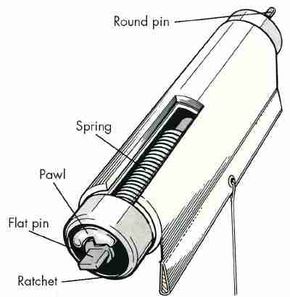How to Fix Window Shades
Every homeowner and apartment-dweller who has ever used window shades is familiar with the many problems that beset them. There's the shade that's so tightly wound it snaps all the way up, the one that's so loose it won't go up at all, and the one that binds at the edges or falls out of its brackets. In most cases, only a simple adjustment is needed to get shades working properly.
A shade that binds is being pinched by brackets set too close together. If the brackets are mounted on the wall or on the outside of the window frame, this is easy to remedy: Tap the brackets slightly outward with a hammer. This technique also may work on brackets mounted inside the window frame. If the shade still sticks, take it down. You'll have to remove some wood from the roller.
Advertisement
Remove the round pin and the metal cap on the round-pin end of the roller. Then sand the end of the roller down with medium-grade sandpaper. Badly binding shades may require further adjustment. If the brackets are mounted on the outside of the frame, you can move one bracket out slightly. Fill the old screw holes with wood plastic. If brackets are inside-mounted, shade will have to be cut down professionally to fit the frame or be replaced.
The opposite problem occurs when the mounting brackets are set too far apart. In extreme cases, the shade may even fall when you try to use it. If the brackets are mounted outside the frame, tap them gently together with a hammer, or move one bracket in closer to the other. If the brackets are mounted inside the frame, you'll have to adjust the space with shims. Take the shade down, and cut a piece of thin cardboard a little smaller than one bracket. Unscrew the bracket, set the shim behind it, and screw the bracket on over the shim. If necessary, add one or more shims to both brackets.
When the shade won't go up or down properly, the roller mechanism is probably at fault. Shades are operated by a strong coil spring inside one end of the roller. The pin that holds the shade up at this end of the roller is flat; this flat pin tightens or loosens the spring when you roll the shade up or down. At the flat-pin end of the roller, the spring is controlled by a pawl and ratchet that stop the movement of the spring when the shade is released. If the shade is too tight or too loose, or if it doesn't stay in place when you release it, there is usually a problem with the spring or with the pawl-and-ratchet mechanism. Unless the spring is broken, this is easy to fix.
If the shade won't stay up, the spring is too loose. Pull the shade down enough to turn the roller a few times; if it's extremely loose, pull it down about halfway. Lift the flat-pin end of the roller out of its bracket. Then roll the shade up by hand, keeping it tightly rolled. Set the roller back on the bracket and try the shade again. If it still doesn't stay up, repeat the procedure.
If the shade snaps up and is hard to pull down, the spring is too tight. With the shade rolled up, lift the flat-pin end of the roller out of its bracket and unroll the shade two or three turns by hand. Replace the roller on the bracket, and test its operation. Adjust it further if necessary.
If the shade won't stay down, the pawl-and-ratchet mechanism may need cleaning. Take the shade down and remove the cap at the flat-pin end of the roller. Vacuum out any obvious dust, and clean the mechanism with a soft cloth. Spray silicone lubricant into the mechanism. Replace the metal cap and rehang the shade.
Venetian blinds are often preferred over shades because they are a long-lasting window treatment. Check the next section for tips on how to keep your venetian blinds working properly no matter how long you use them.
